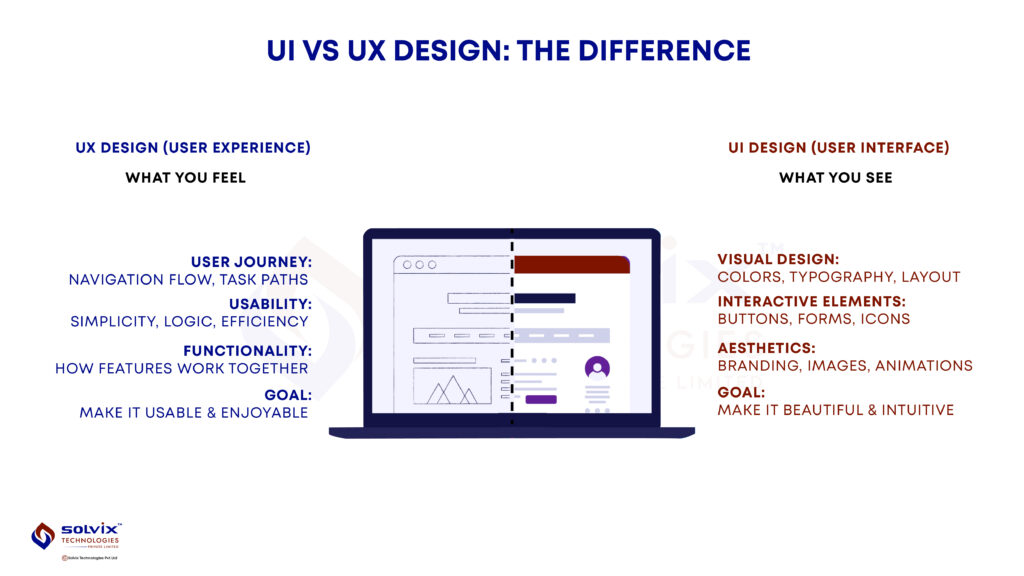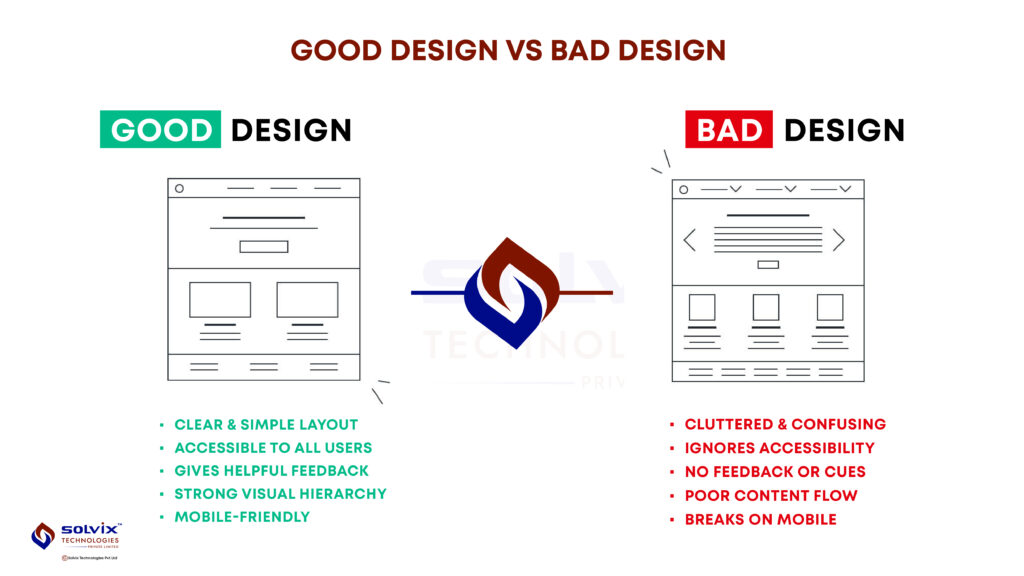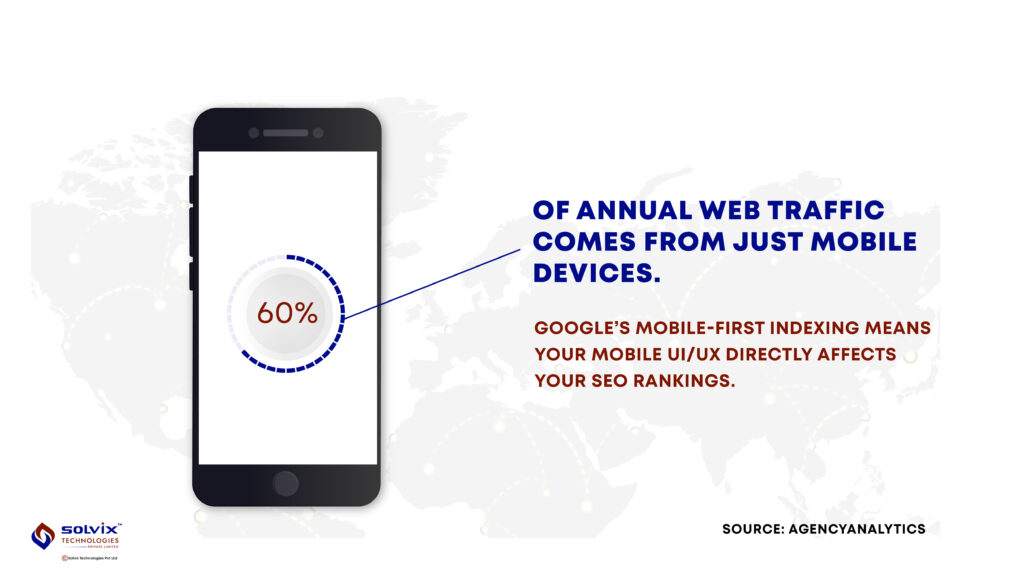No products in the cart.
UI/UX Design Services Explained: Process, Principles & Does It Still Matter in 2025
Think of the last app you deleted from your phone. Chances are, it wasn’t because of a bad product, it was because of a frustrating interface or a confusing experience.
That’s the power (or pain) of UI/UX design.
UI (User Interface) is what people see: layout, icons, typography, and visual identity. UX (User Experience) is how it all works together- the intuitive flow, the frictionless interactions, the way users move through a product without stopping to think.
Together, they’re responsible for how a product feels to use. And that feeling? It makes or breaks conversions, retention, and brand loyalty.
As businesses face rising user expectations and competition in 2025, top-tier UI/UX design services have become a non-negotiable investment, not just for startups and SaaS apps, but for every business that values digital presence.
What Is UI/UX Design?

Despite being tossed around like buzzwords, UI and UX are two distinct disciplines and understanding the difference is crucial.
UI (User Interface)
This is the surface layer. It deals with:
- Colors, shapes, and layout
- Buttons, icons, forms
- Brand visuals, typography
- Micro-interactions and animations
UI is about how your product looks, and whether users find it visually appealing and trustworthy.
UX (User Experience)
This is the structural and psychological layer. It involves:
- User journey mapping
- Task flows and usability
- Cognitive load and information clarity
- Functional structure and logic
UX is about how your product works, and how efficiently users can achieve their goals.
A great example to this – Take a travel booking app.
- A sleek calendar and intuitive date selection? That’s great UI.
- Allowing users to book a flight, car, and hotel in under 3 minutes? That’s exceptional UX.
The best digital products strike the right balance: stunning interfaces layered on seamless functionality.
UI/UX Design Services: What Do Agencies Actually Offer?
So, what exactly does a professional UI UX design agency do? It goes far beyond making things “look nice.”
Here’s what modern UI/UX design services typically include:
1. User Research & Persona Building
Every strong design starts with understanding the target user. Agencies conduct:
- Interviews, surveys, analytics
- Behavior analysis and pain-point discovery
- Creation of personas that reflect different user types
These insights guide every design decision from navigation to layout and content hierarchy.
2. Wireframing & Prototyping
Before pixels come into play, structure is built through:
- Wireframes: Basic, grayscale screens that focus on layout and hierarchy (low-fidelity)
- Prototypes: Interactive models created with tools like Figma UI UX design or Adobe XD, showcasing user flows and interactions.
Prototypes bring concepts to life without writing a single line of code.
3. Figma UI UX Design Workflows
Today, Figma is the backbone of collaborative design. Agencies use it to:
- Create shared libraries of components
- Invite stakeholders into live designs
- Speed up iteration through modular assets
Using Figma UI UX design methods also ensures seamless handoff between designers and developers.
4. Visual Design & Branding Integration
Designs are more than colors and fonts. Agencies ensure:
- Every screen reflects your brand’s voice and tone
- Icons, illustrations, and micro-animations enhance usability
- Emotional design techniques (like color psychology) support conversion
5. Mobile UI UX Design Services
With most users accessing content via mobile, mobile-first design is no longer optional. Agencies prioritize:
- Touch-friendly interfaces
- Vertical flow logic
- Adaptive layouts for all screen sizes
6. Usability Testing & UX Audits
No assumptions. Only data.
- User testing sessions uncover confusion and blockers
- UX audits assess existing platforms against best practices
- Analytics tools track behavior heatmaps and flows
Professional UI/UX design services turn these insights into actionable design fixes.
The UI/UX Design Process: Step-by-Step
Great design isn’t a spark of creativity but a result of a systematic, well-researched process. The most reliable UI/UX design agencies follow a structured framework to ensure consistency, creativity, and clarity at every step.
1. Discovery & Research
Every project begins with a deep dive into the business goals, user behaviors, and competitive landscape. This phase includes conversations with stakeholders to define objectives and expectations. Parallelly, designers analyze existing solutions in the market to identify gaps and opportunities. Most importantly, this is where user research takes center stage. Understanding who the users are, what they need, and where they struggle. The insights gathered here form the foundation of everything that follows.
2. Information Architecture
Once the goals and audience are clear, it’s time to define how users will interact with the product. This step focuses on structuring content and navigation paths that feel logical and intuitive. Designers map out user journeys, create flow diagrams, and build sitemaps, all aimed at reducing friction and making it easy for users to find what they need, when they need it.
3. Wireframing (Low-Fidelity)
Before any color is added or visuals are finalized, designers sketch the raw layout of key screens. These low-fidelity wireframes are intentionally simple, often grayscale focusing solely on structure and hierarchy. They help teams iterate quickly on layouts and user flows without getting distracted by design aesthetics. It’s the blueprint phase of digital architecture.
4. Prototyping (High-Fidelity)
With the structure in place, it’s time to simulate the actual experience. Using tools like Figma UI UX design, designers transform static wireframes into interactive prototypes. These clickable mockups demonstrate how users will move through the product from tapping a button to completing a checkout. At this stage, the design starts to feel real, making it easier to validate ideas with stakeholders and users.
5. UI Design
This is where the visual personality comes alive. Designers apply brand elements like color palettes, typography, imagery, and iconography to the approved wireframes. The goal isn’t just to make the interface attractive, but to create a consistent, accessible experience that reflects the brand’s voice and guides the user naturally. Small details like button shadows, hover states, and animations also get added here.
6. Testing & Iteration
Even the most beautiful design can fall flat without testing. That’s why usability testing is built into the process. Teams observe how real users interact with the prototype, collect feedback, identify sticking points, and revise accordingly. This iterative approach ensures the final product is not only functional, but also enjoyable and intuitive.
7. Developer Handoff
Once the design is finalized, it’s packaged for development. Tools like Figma’s Inspect Mode allow developers to extract specs, assets, and styles directly from the design files. This minimizes the gap between design intent and final implementation. Documentation and design systems are also often shared at this stage to support consistency across future updates.
Principles of Good UI/UX Design

Not all design is good design. Here are the timeless principles guiding effective digital experiences:
Clarity and Simplicity
Users shouldn’t have to think too hard. Clear labels, logical placement, and minimal distractions ensure smoother interactions.
Accessibility
Designs should work for everyone including users with visual, cognitive, or motor challenges. This means:
- Proper contrast ratios
- Keyboard navigability
- Screen reader compatibility
Feedback and Interaction
Every action needs a reaction. Whether it’s a loading spinner or a subtle “success” tick, feedback builds confidence.
Visual Hierarchy
Using size, space, and color to show what matters most. Calls to action, headlines, or navigation paths.
Mobile Responsiveness
Layouts must adapt to different screen sizes and device orientations without breaking usability.
Incorporating these principles into every project is a non-negotiable standard across modern UI/UX design services.
Figma UI/UX Design: Why It’s the Tool of Choice
Figma isn’t just a design tool, it’s a design ecosystem. Here’s why it has become the gold standard in 2025:
- Real-Time Teamwork
Designers, product managers, and developers can all collaborate in the same file. No more endless email threads or versioning issues.
- Component Libraries
Create buttons, forms, cards once can be reused everywhere. This drastically reduces production time and enforces consistency.
- Design + Code Alignment
Developers can inspect spacing, extract code-friendly assets, and understand motion specs directly in Figma.
- Instant Prototyping
Drag-and-drop prototypes simulate user flows without needing InVision or other separate tools.
For every UI UX design agency, Figma UI UX design tools speed up iteration, improve communication, and reduce development bottlenecks.
Mobile UI/UX Design Services: Adapting for a Mobile-First World

As more user journeys begin (and end) on phones, mobile UI UX design services are no longer optional, they’re the frontline of digital interaction.
Here’s what top agencies focus on:
Mobile-First vs. Responsive Design
- Responsive Design adapts desktop layouts to fit mobile screens.
- Mobile-First Design starts with mobile constraints, building up for larger screens. This ensures speed, usability, and relevance.
Touch-Friendly Interactions
- Minimum target size: 48×48 dp
- Avoid hover-reliant UI
- Swipeable carousels, sticky menus, and contextual CTAs
UX-Driven Performance
- Compressing images and assets to reduce load time
- Lazy loading content to prioritize visible elements
- Reducing HTTP requests for faster page speeds
Industry-Specific Solutions
- E-commerce: Sticky add-to-cart, one-tap checkout, large product previews
- Healthcare: Quick access to appointment scheduling, insurance info
- EdTech: Mobile dashboards, personalized learning paths
Tailored mobile UI UX design services give users the speed, clarity, and satisfaction they demand.
Benefits of Hiring a Professional UI/UX Design Agency
Still considering an in-house junior designer or a low-cost freelancer? Here’s what you miss:
Strategy Over Aesthetics
A UI UX design agency thinks beyond fonts and colors. They align design with user goals and business KPIs increasing conversions, reducing churn, and boosting ROI.
Depth of Resources
You gain access to:
- UX researchers
- Motion designers
- Accessibility consultants
- QA testers
This multifaceted team structure creates far better outcomes than a single generalist.
End-to-End Collaboration
Agencies work across functions – design, development, product, marketing ensuring:
- On-time delivery
- Design/dev consistency
- Fewer reworks
Scalable Systems
With libraries, components, and brand kits, agencies build design systems that scale with your product.
Cost-Effective in the Long Run
A poorly designed product costs more in user drop-off, redesigns, and development fixes. Investing in professional UI/UX design services reduces downstream costs.
Common UI/UX Design Mistakes to Avoid
Design mistakes don’t just hurt aesthetics, they harm trust, usability, and business outcomes.
Overdesigning
Too many shadows, animations, or features? It clutters the experience and confuses users.
Ignoring Mobile UX
A beautiful desktop site that breaks on mobile is a bounce magnet.
Skipping Feedback Loops
No user testing = no clue what’s working or not. Design decisions without feedback are educated guesses at best.
No Accessibility
Neglecting users with disabilities isn’t just poor design, it could expose your business to legal issues.
By avoiding these, a UI UX design agency ensures your platform remains competitive and user-friendly.
Does UI UX Design Still Matter in 2025?
If you’re wondering whether UI/UX design still holds weight in 2025, just look at the process top agencies follow today — it’s more strategic, more data-driven, and more essential than ever.
Design begins with research to understand real users, not assumptions. That’s followed by information architecture, where content and flows are structured to reduce friction. Instead of diving into visuals, designers start with wireframes, laying out how users will move through the product. These evolve into interactive prototypes using tools like Figma UI UX design, making it easy to test ideas before a single line of code is written.
Only then comes UI design, where brand identity, accessibility, and consistency shape the look and feel. The process wraps with user testing and developer handoff, ensuring everything works as intended across teams and devices.
In short, UI/UX isn’t just alive in 2025 – it’s the blueprint for every successful digital product. The process itself proves why it still matters. If you’re serious about creating standout digital experiences in 2025, let us help you get there with designs that don’t just look good but perform brilliantly. Contact us today.
